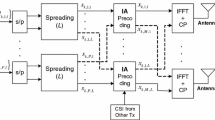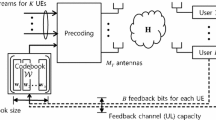Abstract
A signal transmitted through a wireless channel may be severely distorted by intersymbol interference (ISI) and multiple access interference (MAI). In this paper, we propose an efficient CDMA receiver based on frequency domain equalization (FDE) with a regularized zero forcing (RZF) equalizer and parallel interference cancellation with a unit clipper decision function (CPIC) to combat both the ISI and the MAI. We call this receiver the FDE-RZF-CPIC receiver. This receiver is suitable for downlink zero padding CDMA cellular systems. The effects of the decision function, the channel estimation, the number of cancelled users, and the user loading on the performance of the proposed receiver are discussed in the paper. The bit error rate (BER) of the data received by the proposed receiver is evaluated by computer simulations. The experimental results show that the proposed receiver provides a good performance, even with a large number of interfering users. At a BER of 10−3, the performance gain of the proposed receiver is about 2 dB over the RAKE receiver with a clipper decision function and PIC in the half-loaded case (eight users) and is much larger in the full-loaded case (16 users).
















Similar content being viewed by others
References
Martoyo I, Wesis T, Capar F, Jondral F (2003) Low complexity cdma downlink receiver based on frequency domain equalization. in Proc IEEE Vech Tech Conf, pp 987–991, Oct
Pan J, De P, Zeira A (2001) Low complexity data detection using fast fourier transform decomposition of channel correlation matrix. IEEE Global Telecom Conference 2:1322–1326 Nov
Falconer D, Ariyavisitakul SL, Benyamin-Seeyar A, Edison B (2002) Frequency domain equalization for single-carrier broadband wireless systems. IEEE Mag Commun 40(no. 4):58–66 Apr
Petre F, Lues G, Deneire L, Moonen M (2002) Downlink frequency domain chip equalization for single-carrier block transmission ds-cdma with known symbol padding. in Proc GLOBCOM, pp 453–457, Nov
Baum KL, Thomas TA, Vook FW, Nangia V (2002) Cyclic-prefix CDMA: an improved transmission method for broadband DS-CDMA cellular systems. IEEE Wireless Comm And Networking Conference 1:17–21 Mar
Mouhouche B, Abed-Meraim K, Ibrahim N, Loubaton P, Combined MMSE equalization and blind parallel interference cancellation for downlink multirate CDMA Communications. IEEE 5th Workshop on Signal Processing Advances in Wireless Communications, pp 492–496, 11–14 July 2004
Mouhouche B, Abed-Meraim K, Burykh S (2004) Spreading code detection and blind interference cancellation for DS/CDMA downlink. IEEEISS STA ’04, Sydney, pp 774–778
Gao Z, Wu Q, Wang J, Combination of LMMSE equalization and multi-path interference cancellation in WCDMA receivers. IEEE ICMMT 4th International Conference, pp 838–841, 18–21 Aug. 2004
Madkour MF, Gupta SC, Wang YE, Successive interference cancellation algorithms for downlink W-CDMA Communications. IEEE Trans Wireless Comm 1, N. 1, January 2002
Nelson LB, Poor HV (1996) Iterative multiuser receivers for CDMA channels: an EM-based approach. IEEE Trans Commun 44:1700–1710 Dec
Hui ALC, Letaief KB (1998) Multiuser asynchronous DS/CDMA detectors in multipath fading links. IEEE Trans Commun 46:384–391 Mar
Zha W, Blostein SD (2003) Soft-decision multistage multiuser interference cancellation. IEEE Trans Techn 52(No. 2):380–389
Klein A, Kaleh GK, Baier PW (1996) Zero forcing and minimum mean-square-error equalization for multi-user detection in code division multiple-access channels. IEEE Trans Vehic Tech 45(no. 2):276–87 May
Werner S, Lilleberg J (1999) Downlink channel decorrelation in CDMA systems with long codes. IEEE 49th Vehicular Technology Conference 2:1614–1617 16–20
Varanasi M, Aazhang B (1990) Multistage detection in Asynchronous Code-Division Multiple Access Communications. IEEE Trans Commun 38(4):509–519
Klein A, Data detection algorithms specially designed for the downlink of CDMA mobile radio systems. IEEE 47th Vehicular Technology Conference 1:203–207, 4–7 May 1997
Anderws HC, Hunt BR (1977) Digital image restoration. Prentice-Hall, Englewood Cliffs
Biemond J, Rieske J, Gerbrands JJ (1983) A fast Kalman Filter for images degraded by both blur and noise. IEEE Trans Acoust Speech Signal Process ASSP-31(No.5):1248–1256 Oct
Author information
Authors and Affiliations
Corresponding author
Appendix: Toeplitz to circulant approximation
Appendix: Toeplitz to circulant approximation
Let Q be an S × S Toeplitz matrix of the following form:
It can be approximated by an S × S circulant matrix Q c defined as [17, 18]:
where each row is a circular shift of the row above and the first row is a circular shift of the last row. The primary difference between the matrices Q and Q c is that they differ only by elements added in the upper right and lower left parts to produce the cyclic structure in the rows. If S is large and the number of nonzero elements on the main diagonals of the matrix compared to the number of zero elements is small (i.e., the matrix is sparse), the number of elements added to the upper right and lower left corners does not affect the matrix. It can be shown from the eigen value distribution of both matrices that Q and Q c are asymptotically equivalent.
It is known that an S × S circulant matrix Q c can be diagonalized as follows [1]:
where Λ is an S × S diagonal matrix whose elements λ(s, s) are the eigen values of Q c and Ψ is an S × S unitary matrix of the eigen vectors of Q c. Thus, we have:
The elements ψ(s 1, s 2) of Ψ are given by [17, 18]:
for s 1, s 2 = 0,1,........., S − 1 and j 2 = −1.
The eigen values λ(s, s) can be called λ(s). For these eigen values, the following relation holds [17, 18]:
s = 0,1,........., S − 1.
Because of the cyclic nature of Q c, we define:
and thus Eq. 48 can be written in the form [17, 18]:
for s = 0,1,........., S − 1.
Thus, the circulant matrix can be simply diagonalized by computing the discrete Fourier transform of the cyclic sequence q(0), q(1),........., q(S − 1).
Rights and permissions
About this article
Cite this article
Al-kamali, F.S., Dessouky, M.I., Sallam, B.M. et al. An efficient receiver scheme for downlink ZP-CDMA. Ann. Telecommun. 64, 259–268 (2009). https://doi.org/10.1007/s12243-008-0083-9
Received:
Accepted:
Published:
Issue Date:
DOI: https://doi.org/10.1007/s12243-008-0083-9




